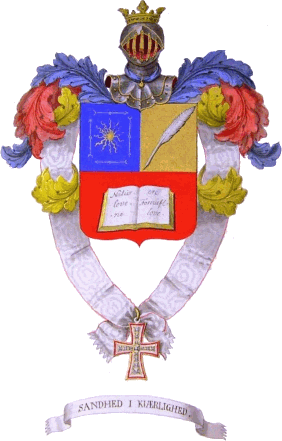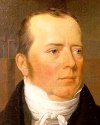

Hans Christian Oersted (1777-1851)
Danish Physicist
[ Electromagnetism, 1820 ]
& Chemist [ isolated Aluminium in 1825 ]
Per fess, per pale;
[1] Azure, a sun in splendor Or between 4 compass needles pointing clockwise;
[2] Or, a quill pen Argent in bend sinister;
[3] Gules, on an open book Argent, the Danish words
"Naturlovene ere Fornuftlove"
(the Natural laws are laws of reason).
[ June 25, 1847 ]
Mantling : Under a mantling of the colors, the cross of the
Danish Order of the Dannebrog,
hanging from its own ribbon (Argent fimbriated Gules).
Motto : Sandhed | Kiærlighed
(truth | love).
[ Thanks to Ronny Andersen, Sunil Saigal and Jochen Wilke
for their heraldic
contributions. ]
The following text
by Louis-Guillaume
Le Monnier appears
(in
French) in the monumental
Encyclopédie
of Diderot and d'Alembert (71818 articles in 35 vloumes, the first 28
of which were edited by Diderot himself and published between 1751 and 1766).
" A violent electric spark can modify a compass or magnetize small needles,
according to the direction given to that spark.
It has long been observed that a bolt of lightning (which is only a large electric spark)
is able to magnetize all sorts of iron and steel tools stored in boxes and to give the
nails in a ship enough magnetic properties to influence a compass at a fair distance.
This formidable fluid has simply changed into true magnets
some iron crosses of ancient belltowers
that have been exposed several times to its powerful effects. "
With his famous kite experiment
in June 1752, Benjamin Franklin had established the connection between lightning and electricity
which Le Monnier talks about as common knowledge in the above quote.
Well before that time, people had indeed remarked
that the needle of a compass goes haywire near a bolt of lightning.
However, the rest of the havoc brought about by lightning is apparently
so overwhelming that this comparatively delicate aspect was never properly
investigated.

Hans Christian Ørsted
|
|
The critical link between electricity and magnetism was established
in less stressful circumstances :
On April 21, 1820, the Danish physicist Hans Christian
Ørsted (1777-1851)
was preparing demonstrations for one of his lectures
at the University of Copenhagen.
He observed that a compass needle was deflected when a large electrical current was
flowing in a nearby wire.
This precise instant marks the birth of
electromagnetism,
the study of the combined effects of electricity and magnetism.
Contrary to popular belief,
the discovery of Oersted was not entirely a chance
accident (R.C. Stauffer, 1953). As early as 1812,
Oersted had published speculations that electricity and magnetism were
connected. So, when the experimental evidence came to him,
his mind was prepared to make the best of it.
François Arago
(1786-1853; X1803) was the first person to
build an electromagnet, in September 1820, by placing iron in a wire coil.
Hans Christian Ørsted received the insignias of the
Prussian Order of Merit, the French Legion of Honor, and the Danish Order of the Dannebrog.



